Efficiency Ahead: How State Energy Efficiency Plans are Driving Utility Bill Savings and Benefits Across the Northeast
Report
Acadia Center announces release of new report “Efficiency Ahead: How State Energy Efficiency Plans are Driving Utility Bill Savings and Benefits Across the Northeast.”
Acadia Center’s latest report highlights the essential contributions energy efficiency programs make to stabilizing costs, benefitting ratepayers, and diversifying the energy mix in seven states in the northeast.
Efficiency Ahead further recommends how standardizing metrics by states for program measurement, evaluation, and reporting would increase value.
ROCKPORT, ME – Acadia Center announces its new report: Efficiency Ahead: How State Energy Efficiency Plans are Driving Utility Bill Savings and Benefits Across the Northeast. This new analysis takes a closer look at the most recent energy efficiency plans developed by the six New England states and New York. It examines program investment levels, projected benefits and energy savings, cost-effectiveness levels, the impact of recent proposed funding cuts, and states’ progress relative to their peers on criteria like per-capita investment levels.
“State energy efficiency programs make a major contribution to the energy system as a low-cost resource, yet face a pivotal juncture in the northeast region,” said Jamie Dickerson, Senior Director, Climate and Clean Energy Programs. “Consumer affordability is front of mind for consumers and policymakers with rising energy prices. Other energy resources are rising in cost, yet cuts to ratepayer funded programs – which reduce system costs – have been threatened and implemented by leading states. It is more important than ever for policymakers, advocates, program administrators, and consumers to understand the value and evolving role of energy efficiency resource acquisition and shape the future trajectories of the programs to meet the emerging needs of the region.”
Each state in the Northeast operates and administers energy efficiency programs funded via electricity and natural gas bills to deliver energy efficiency and electrification improvements to customers. These ratepayer-funded energy efficiency programs have been and remain the largest source of investment in efficiency and building decarbonization for the region. These state programs have been operating for decades and provide major overall benefits in the form of reduced overall building energy consumption, energy cost savings to residents and businesses, reduced peak demand stress on the region’s electricity grid, and reductions in greenhouse gas (GHG) emissions, in addition to significant job creation and economic development increases.
The analysis conducted by Acadia Center in this report draws on publicly available data reported in each state’s three-year energy efficiency plan, annual program reports, and related filings. The analysis in the report yielded the following findings for program activity in the next three years:
- Record-level investments and lifetime benefits: Seven states poised to invest almost $10 billion in efficiency overall, with New England programs alone generating an estimated $19.3 billion in lifetime benefits.
- Significant electricity and fuel savings: New England and New York combined are expected to realize 700 trillion British thermal units (TBtu) in lifetime savings across all fuels, including 20 terawatt-hours (TWh) of electricity savings (lifetime) from efficiency investments in New England—equivalent to 5.2 million homes using natural gas for one year in New England.
- Wide range in per-capita investments by state: Program budgets range from $149 per capita in New York State to $631 per capita in Massachusetts—revealing differences in population, portfolio mixes, cost-effectiveness screening, and overall program ambition.
- Missed benefits from recent budget cuts: Massachusetts will lose out on $1.49 billion in lifetime benefits, 20 TBtus of energy savings, and 1.8 million metric tons (MMT) of carbon dioxide equivalent (CO2e) emissions by cutting $500m in program budgets. Rhode Island too faces cuts of 30% that would lose the state some $92m in benefits.
- Strong ongoing cost-effectiveness: Each dollar spent on efficiency yielding $2.93 in benefits across New England, on average—indicating an opportunity to increase investment levels further and acquire deeper cost-effective savings across the region.
- Major contributions to the region’s grid: Electric savings will help the region continue meeting a substantial portion of annual electric load via energy efficiency (20.6 TWh saved in 2023, or almost 15% of gross load).
While the benefits delivered by these programs are impressive, state program data were not easy to compile, and cross-state comparisons are made quite challenging by significant variations in reporting methodologies and data formatting across states. Cross-state collaboration to enable more uniform reporting would enable stakeholders to better communicate the significant positive benefits these programs are having on a regional scale.
“State energy efficiency programs are well positioned in the coming years to reduce overall building energy consumption, deliver energy cost savings to residents and businesses, reduce peak demand stress on the region’s electricity grid, and deliver reductions in greenhouse gas (GHG) emissions—all despite the changing overall landscape for efficiency investments and available funding sources,” said Ben Butterworth, Director of Climate, Energy, and Equity Analysis at Acadia Center and a lead author on this report. “Looking ahead, improving program design and administration can achieve even larger consumer and system benefits.”
MEDIA CONTACT
Jamie Dickerson
Senior Director, Climate and Clean Energy Programs
jdickerson@acadiacenter.org; 401-276-0600 x102
Statement on Chair Marissa Gillett’s Resignation from the Connecticut Public Utilities Regulatory Authority
September 24, 2025
MEDIA CONTACTS
Will Taylor
Strategy Director, Infrastructure and Resilience
wtaylor@acadiacenter.com; 860-246-7121 x203
Noah Berman
Senior Policy Advocate and Utility Innovation Program Manager
nberman@acadiacenter.org; 617-742-0054 x107
Acadia Center applauds Marissa Gillett’s tenure as Public Utility Regulatory Authority Chair and highlights her accomplishments in the role.
Encourages next PURA Chair to “maintain a strong stance on what rates are just and reasonable, and further the work done to establish Connecticut as a national leader in modernizing utility ratemaking.”
HARTFORD, CT – Public Utility Regulatory Authority’s (PURA) Chair Marissa Gillett’s tenure has witnessed significant accomplishments regarding cost savings and modernizing Connecticut’s approach to setting rates and establishing a performance-based ratemaking framework. “Chair Gillett consistently sought fair outcomes when utilities came to PURA to adjust their rates, ensuring only costs that were truly prudent and reasonable would be passed on to ratepayers,” said Will Taylor, Strategy Director, Infrastructure and Resilience, at Acadia Center. “Her unswerving dedication to utility prudence has been a bulwark to Connecticut ratepayers, saving them millions of dollars in rate increases.” Notable advances made throughout the Chair’s tenure, which have withstood judicial scrutiny five times at the Connecticut Supreme Court, include:
- In 2024, PURA directed the Connecticut Natural Gas (CNG) and The Southern Connecticut Gas (SCG) Companies to return $24 million and $96 million to ratepayers over 3 years, respectively. In part because of these directives, the revenue requirements approved by PURA represented $24.6 million and $10.7 million in reductions from current revenues.
- In 2023, PURA approved rates for Aquarion Water Company that represented an average decrease to customer bills of $67/year. Paired with the Water Infrastructure Conservation Adjustment (WICA) surcharge being reset to $0; customer rates were decreased 11%. This ruling included a reduction of requested revenue requirements for operations and maintenance costs of $10.7 million, because the company failed to show they would benefit ratepayers. Aquarion had requested an increase of $37 million in distribution revenues.
- In 2023, PURA approved rate adjustments for The United Illuminating Company (UI), increasing bills by 2% in response to UI’s requested rate increase of 11% over 3 years. Under Chair Gillett, PURA determined that a return on equity of 9.10% was sufficient, but not more than sufficient, to allow the Company a reasonable return—much reduced from the 10.20% ROE proposed by the company. Holding the utility accountable, PURA included a downward adjustment of 0.47% to an effective ROE of 8.63%, reflecting UI’s management and operational deficiencies.
- In 2025, PURA advanced a new framework for performance-based ratemaking (PBR) by issuing three draft decisions that lay out how Connecticut’s utilities will be regulated going forward. The draft rulings propose shifting utilities onto multi-year rate plans with revenue caps, adopting clear performance scorecards and financial incentives tied to reliability, affordability, clean energy, and equity, and requiring a transparent grid planning process that evaluates non-wires alternatives alongside traditional investments.
These decisions represent significant achievements in reducing ratepayer costs while advancing affordable clean energy. PBR in particular is a critically important step to modernize Connecticut’s outdated approach to utility ratemaking. PBR is a common sense, alternative utility regulatory framework that ties financial incentives for utilities to measurable performance outcomes rather than simply allowing recovery of costs for capital investments. PBR helps to align utility behavior with customer interests and public policy goals. It encourages cost efficiency, innovation, and improved service quality while promoting clean energy adoption, equity, and resilience by removing traditional cost-of-service biases. For ratepayers, a successful PBR framework means that utility financial success is more directly linked to delivering tangible benefits — such as lower costs, better reliability, and progress on clean energy — than to how much the utility spends. That should be welcome news for the people of Connecticut.
Under Chair Gillett, PURA has ensured that utility returns are sufficient but prudent — resulting in at least tens of millions of savings for ratepayers — and worked diligently to establish a PBR framework to bring cheaper, cleaner, and more reliable power to the people of Connecticut for many years to come. “Chair Gillett has faithfully served the people of Connecticut by advancing a more affordable, equitable, and sustainable energy future,” said Taylor.
“It is regrettable that she has been subjected to such an unrelenting barrage of attacks while consistently fulfilling her duties. Acadia Center hopes that the next PURA chair will maintain a strong stance on what rates are just and reasonable, and further the work done to establish Connecticut as a national leader in modernizing utility ratemaking.”
Acadia Center Responds to Governor McKee (RI)’s Rate Relief Announcement
September 12, 2025
The two settlements highlighted in the Governor’s rate relief announcement are examples of our regulatory bodies holding the utility accountable to their obligations and refunding money already owed to ratepayers. Acadia Center thanks the DPUC and PUC for their tireless efforts on this front and appreciates the immediate relief these returns offer for Rhode Islanders struggling with energy costs.
However, we cannot rely on settlements alone to provide rate relief year after year in the future. In addition to ongoing regulatory oversight, Rhode Islanders need long-lasting, renewing tools to help protect against rising energy costs. Energy efficiency is one such key tool – it lowers energy bills year after year, at the household and business level and across the gas and electric systems by proactively reducing supply and infrastructure costs.
Unfortunately, Rhode Island’s energy efficiency programs are facing significant cuts this year, despite cost-effectively providing tangible benefits for Rhode Islanders. Acadia Center urges that proposed program cuts be reversed and the accompanying savings be added to an even more robust and enduring rate relief package from the McKee Administration this fall.
Reporting by the Providence Journal
Media Contact:
Emily Koo, ekoo@acadiacenter.org, 401-276-0600 x402
Statement on Trump Administration Offshore Wind Orders
Contact: Jamie Dickerson – Senior Director, Climate and Clean Energy Programs; jdickerson@acadiacenter.org, 401-276-0600 x102
Acadia Center issued the following statement on the latest actions by the Trump Administration against offshore wind. This is a developing story.
Offshore wind stoppages from the Trump Administration will drive up consumer costs, jeopardize grid reliability, and kill thousands of good-paying jobs
Actions will make energy more costly, less reliable, and more polluting
“Actions taken by the Trump Administration to halt critical offshore wind projects and port infrastructure along the east coast will increase utility bills for families and businesses by hundreds of millions of dollars annually, jeopardize reliable power, and kill thousands of good-paying, union jobs,” said Jamie Dickerson – Senior Director, Climate and Clean Energy Programs at Acadia Center. These stoppages and withdrawn grants will make energy systems more vulnerable to extreme weather events, wreak further damage on federal-state energy system planning and collaboration, and erode investor confidence and market stability – undermining future investment in urgently needed grid infrastructure. From any point of view, halting work on established wind projects that states energy officials are relying on to meet power needs, clean the air, and reduce system costs defies the facts and simply makes no sense.
The August 29 announcement withdrawing and cancelling significant offshore wind port infrastructure funding comes just one week after the stop work order halting progress on the 80% complete Revolution Wind project, which was slated to begin delivering 700 MW of power to Connecticut and Rhode Island in 2026. Other affected port projects in the northeast include those in: Bridgeport, CT ($10.5m); Paulsboro, NJ ($20.5m); Quonset, RI ($11.2m); Staten Island, NY ($48m); and Salem, MA ($33.8m). Without investment in these critical port facilities, the region’s economy and infrastructure will be severely damaged. Further reporting now indicates the Trump Administration may also reconsider previously approved permits for SouthCoast Wind, serving Massachusetts.
Last week, a new study conducted by Daymark Energy Advisors on behalf of RENEW Northeast, found that offshore wind would have saved New England ratepayers at least $400 million in utility bill costs last year, lowering energy market prices by 11% and insulating ratepayers from expensive, volatile natural gas. Today, the grid is dangerously over-reliant on natural gas, which provides over 50% of electricity generation in New England. This overreliance costs ratepayers dearly, with volatility in natural gas prices imposing an extreme burden on ratepayers: on average, the region spends around $3 billion per year on natural gas for power generation, and recently, the region saw a 67% price increase between 2024 and 2025 due to a 112% jump in the price of natural gas (see: ISO New England report). Offshore wind is an effective hedge against this volatility, provide sorely needed on-peak production, and reducing fuel-burn to keep supplies available and replenished during extended cold-snap periods.
The bottom line: analysis after analysis provides compelling evidence that offshore wind will lower utility bills for households in New England and the Northeast. Acadia Center calls on policymakers and stakeholders to hold the Trump Administration accountable for the direct financial harms these project delays and stoppages have and will continue to inflict on families and businesses across the region.
Highlights of this and previous studies on offshore wind and energy affordability include:
Daymark Energy Advisors (August 2025):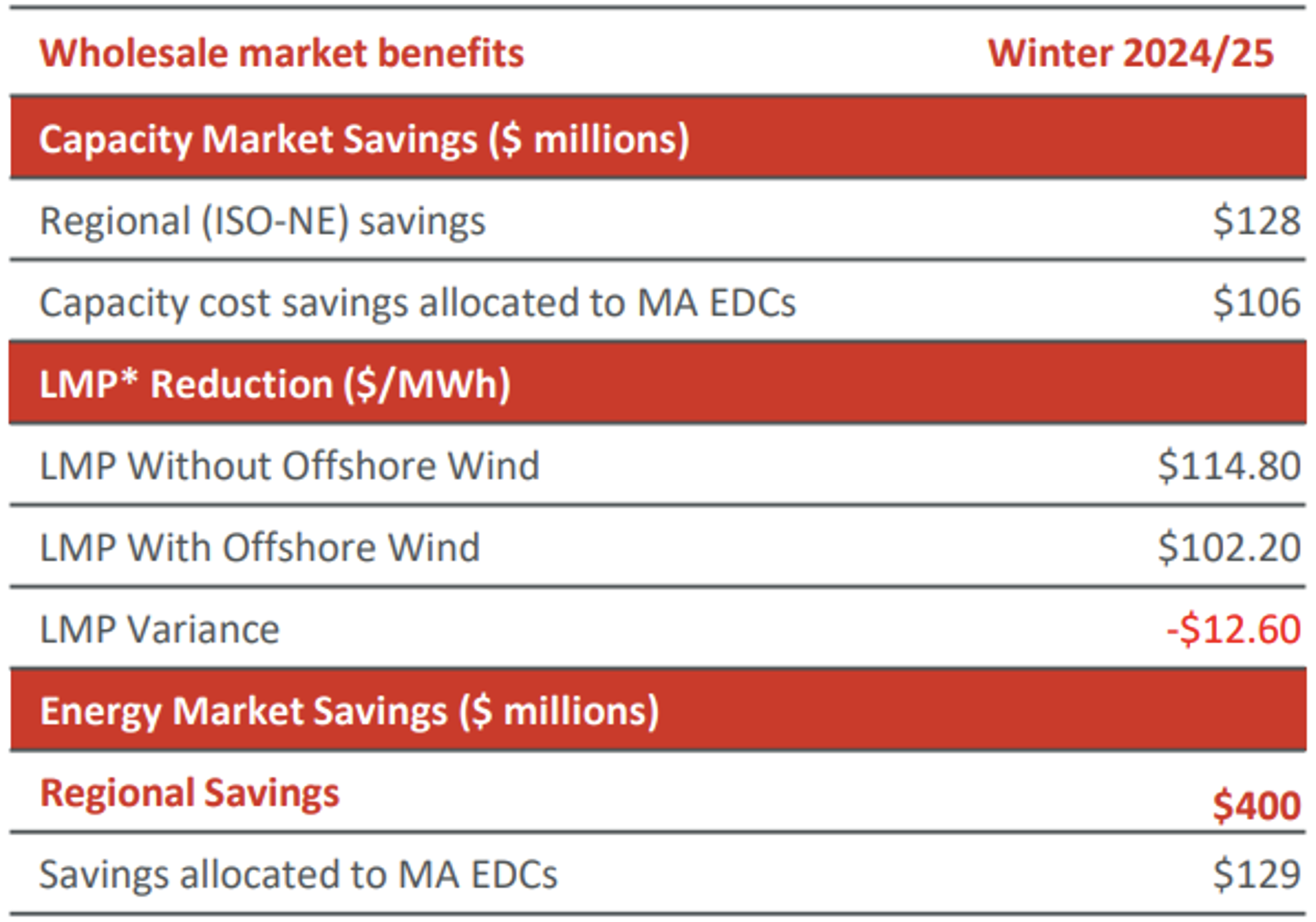
Offshore wind would have lowered wholesale energy prices by 11%, saving ratepayers roughly $400m in Winter 24/25.
Under most conservative assumptions additional capacity from OSW would have reduced regional capacity market costs by at least $128 million.
Net bill impact for average residential customers of $1.32 to $2.68/month in savings, even under most expensive PPA scenarios.
Aurora Energy Research (May 2025):
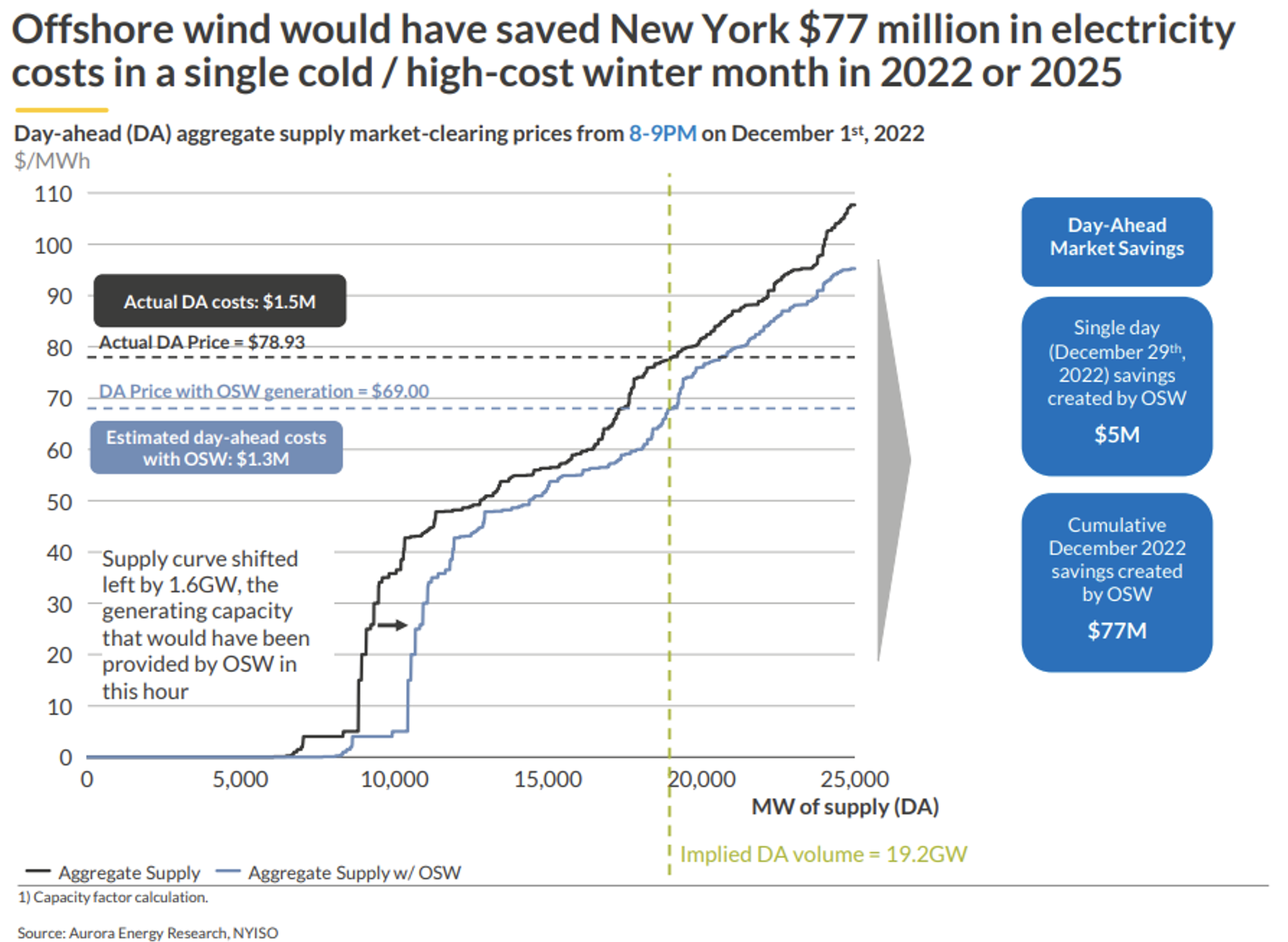
Offshore wind would have saved New York $77 million in electricity costs in a single cold/high-cost winter month in 2022 or 2025.
In analysis of real market conditions in December 2022, study concluded that Empire Wind, Sunrise Wind, and South Fork Wind Farm would have saved New York $77 million.
Even higher wholesale prices in January 2025 would mean even higher savings likely greater than $80m.
Synapse Energy Economics (June 2024):
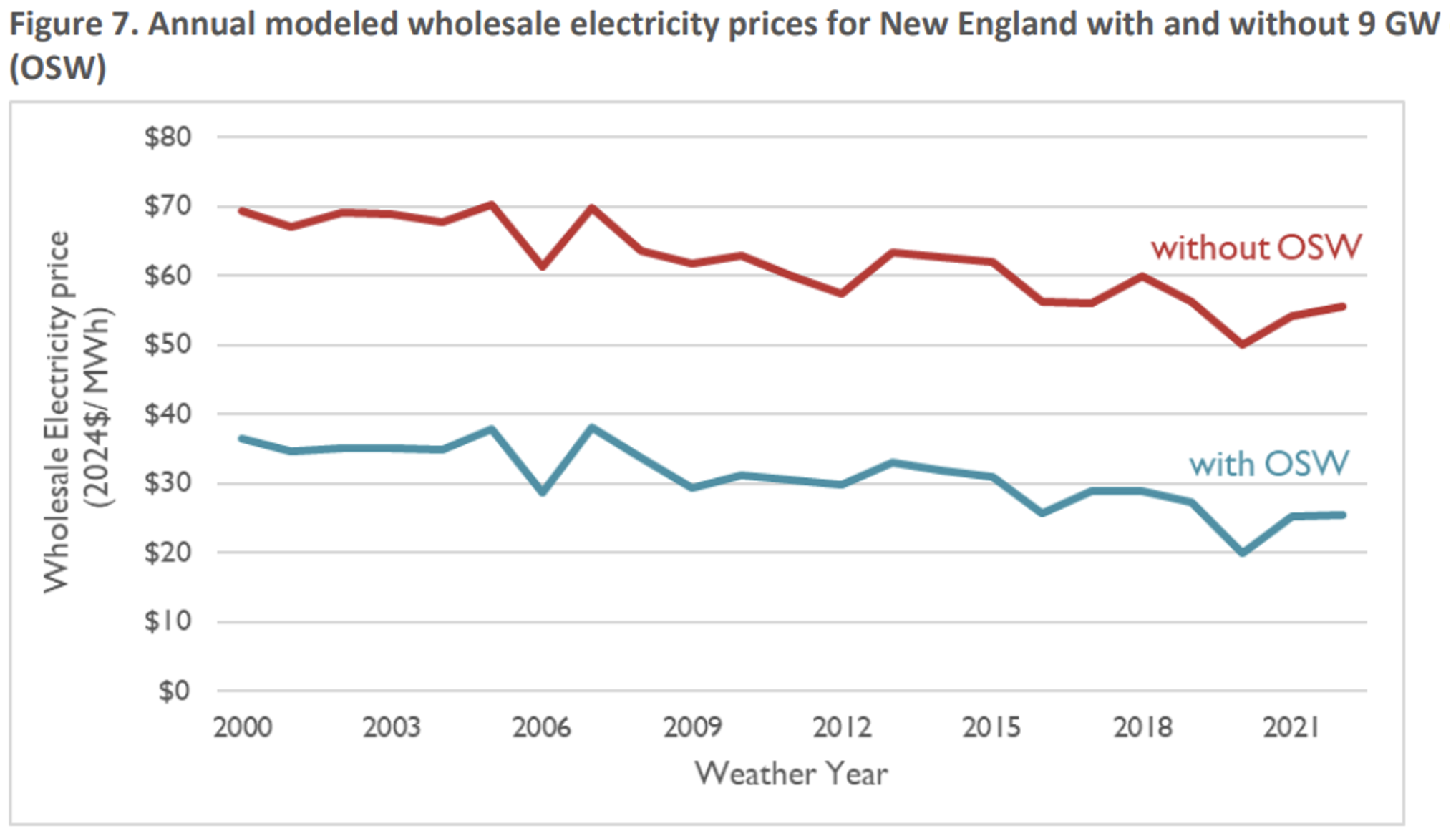
Nine GW of OSW by 2030 would reduce New England electricity bills by approx. $630 million to $1.7 billion annually under mid and high gas price scenarios, reducing customer bills by $2.79 to $4.61/month.
Would halve region’s spends on natural gas for power gen. (~$3b annually), help region retain $1.57 billion otherwise flowing out of region.
ISO-NE and MassCEC (December 2018):
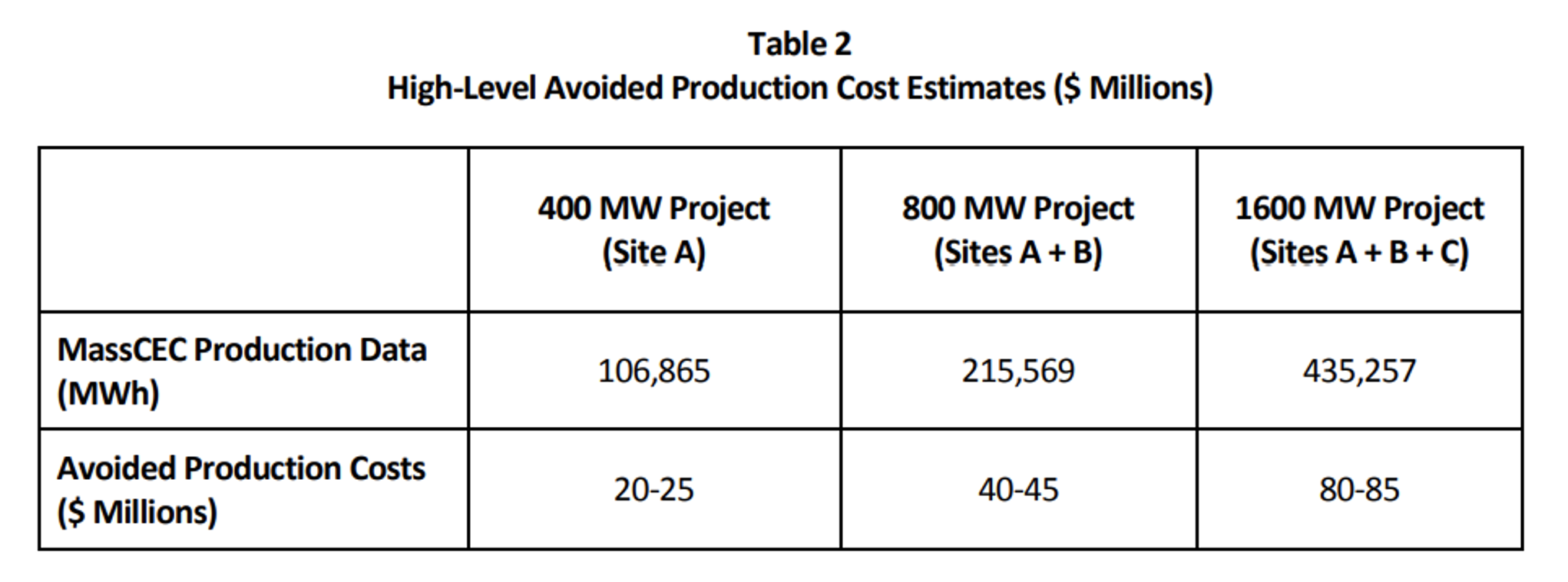
Over a 16-day cold-snap period, 400 to 1,600 MW of offshore wind would have yielded $20 to $85m in avoided power production costs.
Production would have reduced day-ahead locational marginal prices (LMP) by 4% to 13%.
FOR RELEASE: RGGI States Finalize Program Updates to Support Clean Air and Affordable Energy through 2037
MEDIA CONTACTS
Paola Moncada Tamayo
Senior Policy and Data Analyst
ptamayo@acadiacenter.org; 860-246-7121 x204
Jamie Dickerson
Senior Director, Climate and Clean Energy Programs
jdickerson@acadiacenter.org; 401-276-0600 x102
ROCKPORT, ME – On Thursday, July 3, 2025, the ten states participating in the Regional Greenhouse Gas Initiative (RGGI) announced the conclusion of the program’s Third Program Review, finalizing a long process for updates aimed at reinforcing the region’s power sector transition and related climate and energy affordability goals. The agreement by the states will allow for the program’s benefits to continue through 2037, which to-date have brought $20 billion in energy bill savings through the investment of proceeds. RGGI has proven the power of multi-state collaboration, and the continuation of the program will ensure steady investments to benefit consumers, address energy affordability, support communities, and increase economic output. The agreement includes several important changes to strengthen and future-proof the program for consumer and community benefits, including: a strengthened emissions cap through 2037, new market mechanisms, the removal of offsets for program compliance, and a commitment to continued progress. Acadia Center applauds the RGGI states and RGGI, Inc., for bringing this updated model rule to fruition during a period of unprecedented uncertainty.
“RGGI has long demonstrated its effectiveness in providing consumers with large benefits in energy savings and investments in a cleaner future” said Daniel Sosland, president of Acadia Center. “RGGI program improvements reflect the power of bipartisan states’ cooperation to work together toward a cleaner energy future. We look forward to supporting their efforts as they move into the implementation phase and ensuring that the benefits of this program reach households and communities across the region.”
The conclusion of the program review and associated updated model rule bring clarity to several important program and market mechanisms that affect the program’s operation and its resulting impacts to power plants, communities, consumers, and other stakeholders. The program mechanisms described below will work together not only to reduce detrimental pollution that harms public health, but also to enhance the program’s ability to keep delivering tangible financial and energy benefits to consumers and the public.
Key Program Updates:
- Stronger Emissions Cap: Beginning in 2027, the new regional cap puts the ten states on a declining trajectory to reach just under 10 million tons of carbon dioxide equivalent (CO2e) emissions from the power sector by 2037, down from a cap of 82 million tons of CO2e emissions today and a cap of 188 million tons CO2e when the program first held auctions in 2008. Backed by state policy and consistent market direction, it is a positive step forward that demonstrates a strong, multi-state commitment to grid decarbonization.
- Removal of Offsets: Historically, the RGGI program has allowed power generators to use offset allowances representing GHG reductions achieved outside the power sector (e.g., avoided agricultural methane) to meet their emission reduction requirements. RGGI will no longer issue offset allowances beginning in 2027, simplifying program design and reinforcing the focus on direct emissions reductions in the power sector.
- A New Cost Containment Reserve Market Mechanism: A two-tier Cost Containment Reserve (CCR) will be instituted with the objective of helping manage cost volatility while maintaining cap integrity across the ten-state region.
- Minimum Price Floor: The existing Emissions Containment Reserve (ECR) will be replaced by a higher minimum price floor, set at $9 in 2027 and increasing by 7% annually, ensuring RGGI sends a stronger lower bound price signal to power generators.
The updated Model Rule provides the framework for each participating state to revise its own rules through legislative or regulatory processes, with the goal of implementing these changes by January 1, 2027.
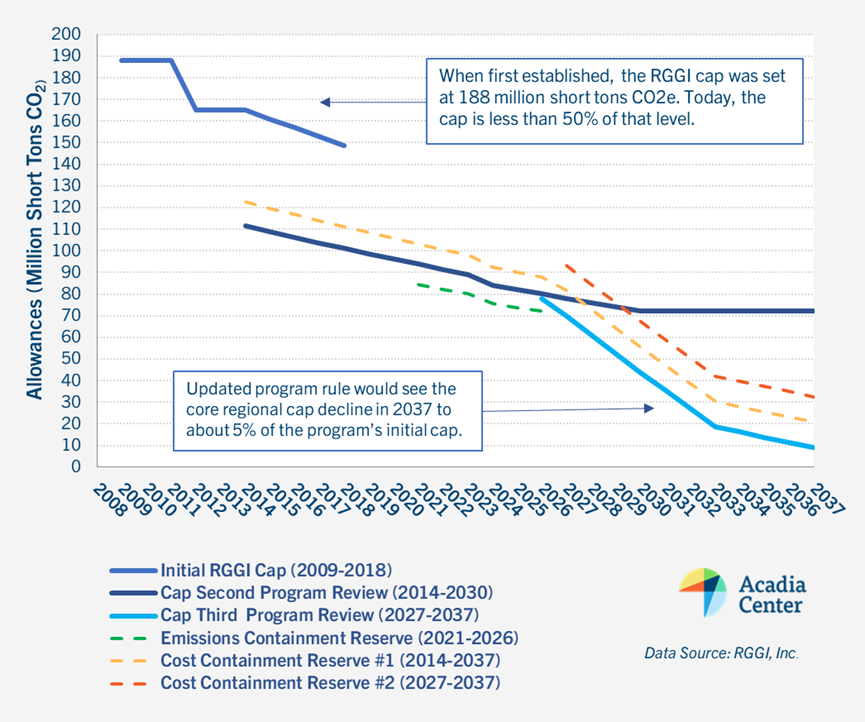
Since the first auction in 2008, RGGI has steadily evolved through three program reviews to become an effective policy tool for emission reductions and regional collaboration. The chart above illustrates how the emissions cap has tightened significantly over time, from an initial 188 million tons to a projected 10 million tons in 2037. The new cap trajectory from the Third Program Review sends a strong signal to markets and power providers that the decarbonization of the power sector is not only possible but already underway across the region and expected to continue, irrespective of countervailing changes at the federal level.
Acadia Center’s full set of Findings and Recommendations for the Third Program Review Report helped shape the discussion by offering proposals to strengthen program impact, enhance equity in proceeds spending, and address other longer-term elements of the program’s evolution.
A Proven Track-Record of Success
RGGI is the United States’ first multi-state program designed to reduce pollution from power plants, providing significant benefits for the participating states and their consumers and communities. Since its inception, RGGI has contributed to nearly 50% reduction in CO₂ emissions from covered power plants. The program has generated over $9 billion in proceeds, which states have invested in clean energy, energy efficiency, and bill assistance programs that benefit local communities and consumers.
RGGI announced that program investments have directly benefited more than 8 million households and 400,000 businesses and are expected to save ratepayers over $20 billion on energy bills. A recent analysis by Acadia Center, RGGI Proceeds in Action, highlights in further detail how states have used these investments to deliver benefits to communities and consumers, along with recommendations for improved reporting and proceed investments.
Looking Ahead
As part of this announcement, the RGGI states have committed to launching a Fourth Program Review no later than 2028. This future review will assess the performance of the newly adopted changes, consider additional adjustments as needed, and further explore opportunities to ensure a reliable, equitable, and clean electricity system across the region.
The updated framework also leaves the door open for future participation by additional states, which would bring greater economic efficiency and climate benefit to the region as a whole.
The graph above focuses on the cumulative RGGI cap over the 200-2037 time period for the ten states that currently participate in RGGI and assumes New Jersey did not exit the program from 2012-2019 for the sake of visual clarity.
APRIL FOOL’S GOLD: Acadia Center Responds to Latest Fossil Fuel Interest Attacks on Clean Energy Policies in New England
MEDIA CONTACT:
Kyle Murray
Director, State Program Implementation
kmurray@acadiacenter.org, 617-742-0054 ext.106
No, it’s not an April Fool’s Day prank: following their easily debunked November energy cost report, fossil fuel-interest think tanks are back with a new round of the same tired and misguided attacks against clean energy policies in New England. Today, the groups – including Americans for Prosperity, the Josiah Bartlet Center for Public Policy, the National Federation of Independent Businesses, the Maine Policy Institute, Massachusetts Fiscal Alliance, and Rhode Island Center for Freedom and Prosperity – held an online press conference to discuss “the effects of alternative energy mandates on the region’s taxpayers.” Since their last flawed analyses, New Englanders have endured a cold and costly winter when it comes to energy bills. The tally of these costs lays bare the region’s untenable overreliance on fossil fuels, with rising energy burdens driven by natural gas infrastructure, generous utility profits, and the region’s continued fossil fuel investments – all exacerbated by reckless actions from the Trump Administration.
With the costs of New England’s fossil fuel reliance growing, clean energy and energy efficiency now have the potential to deliver even greater benefits to families and businesses across the region, by mitigating and avoiding precisely the kind of price spikes seen this winter. New England wholesale electricity costs exceeded $10 billion in 2024 for the third time in four years, a period that saw natural gas grow to unprecedented levels of overreliance (51% of net energy for load in 2024). One program giving payments to dual-fuel (gas-oil) power plants, the inventoried energy program (IEP), cost ratepayers almost $80 million over just five days this winter. And gas heating customers felt the pain too, with natural gas spiking to an average of almost $17/MMBtu in the month of January (a 120% increase over the prior January), and the region’s growing gas distribution networks pushing up delivery costs to previously unseen levels. Energy efficiency programs like Mass Save, touted as the Boogeyman for rising costs, are actually saving customers money by preventing needless additional expenditures on fossil fuels at such costly rates. For example, Rhode Island’s 2024-2026 energy efficiency plan is helping avoid almost $50m in added costs if load was instead met by purchasing additional electric supply.
Figure 1 and 2: New England Wholesale Electricity Costs and Sources of Grid Electricity (source: ISO-NE)
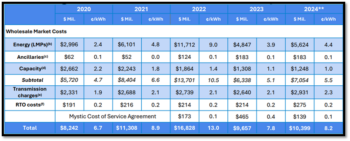
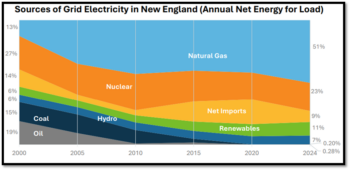
The takeaway for the region remains true: New England has a once-in-a-generation opportunity to redesign and revolutionize its energy system with clean energy and localize the job-creation and GDP impact of energy expenditures within the regional economy, rather than export them afar. Right now, the region has almost all its eggs in the fossil fuel basket, and this offers only the false promise of fool’s gold in protecting the region’s consumers from rising energy bills. The region must double down on its climate and clean energy goals to make the broader northeast region energy independent from fossil fuels, reduce consumer price spikes, and mitigate the economic harms of worsening climate change.
It’s time to set the record straight once again:
False claim #1: the region’s aggressive renewable climate energy policies are a major driver of high utility bills in New England.
Don’t let them fool you: New England spends $76b per year on energy, the majority of which still goes to fossil fuels from outside the region (source: EIA data for 2022). Plus, it was very, very cold this winter; the coldest winter since 2014-2015, in fact.[1] According to data compiled by Acadia Center (see figure 3 and 4 below), the average temperature in December 2024 was a full 10°F colder than December 2023. Further, from December 2024 through February 2025, Massachusetts saw 23 days colder than 20°F, compared to only nine such days the year prior. These colder temperatures generally mean that residents are using more energy, driving up bills.
Figures 3 and 4: Quantifying Winter 2024-2025 Cold Intensity (source: Acadia Center)
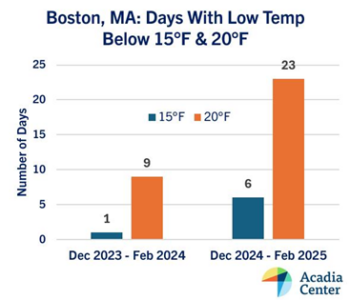
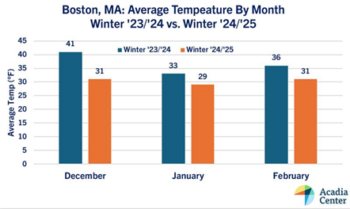
However, due to the Commonwealth’s overreliance on natural gas and other fossil fuels, it also means higher costs for the supply of energy. As America exports more liquefied natural gas (LNG) abroad, domestic gas prices are increasingly tied to the unpredictability of global gas markets, leading to increased price volatility for consumers. By contrast, renewable energy contracts provide a means of locking in affordable prices/rates over a long period of time, helping hedge and insulate the region from the volatile swings in fossil fuel commodity prices seen this winter. Had the Trump Administration not brought offshore wind development to a grinding halt, more high-value offshore wind resources would be available to mitigate winter price spikes and deliver much needed winter resource adequacy in the winters to come.
On the gas side, existing gas customers pay a disproportionate share of the costs for bringing new customers online. Since 2018, existing gas customers have footed the bill for 80% of all new gas customer connections. And these subsidies – known as line extension allowances – are driving up gas bills for everyone. In 2023 alone, Massachusetts gas customers were charged $160 million to add new customers to the gas system, to the tune of $9,000 per new customer, which is reflected on ratepayer gas bills. The cost of adding new customers is rising as well: the average cost of adding new customers rose 50% between 2020-2021 and again in 2022-2023. In fact, despite an acknowledgement by the state and by utilities that we should be winding the gas system down – not expanding it – the growth of the sprawling pipe network shows no signs of stopping. According to analysis from the Attorney General’s Office in Massachusetts, the path we’re currently on could see the state’s gas rate base – the total value of gas system assets on which utilities are allowed to earn a rate of return – jump from $10 to $20 billion in the span of roughly a decade, when factoring in the cost of new and replaced gas pipes.
Figure 5: Analysis of Growth Trajectory for Gas System Rate Base in MA (source: Joint Direct Testimony of Brattle Group on behalf of the MA Attorney General’s Office, DPU 24-GSEP-01, Feb. 2025)
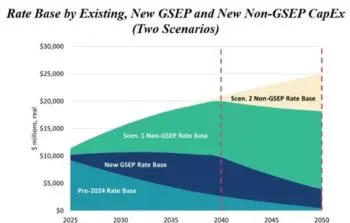
False claim #2: state laws requiring net zero by 2050, which are driving up costs for families and businesses.
As we wrote back in November, extensive modeling previously conducted by Massachusetts for the Commonwealth’s ‘2050 Decarbonization Roadmap’ and Clean Energy and Climate Plans (CECP) provide evidence for a much different trajectory for regional energy prices tied to achievement of 2050 climate targets. These studies included granular region-wide energy system modeling to arrive at their results for Massachusetts customers:
- The 2025/2030 CECP found: “The increased adoption of electrified transportation and heating systems means that the average Massachusetts household will spend less money on energy every year. Average overall household energy expenditures, which include transportation-related fuel costs (included as “energy” cost in this analysis), are projected to decline 8% by 2030 relative to 2019 levels, for an average household savings of $400 per year.”
- The 2050 CECP found: “the efficiency gains of electrification will result in lower household energy expenditures through 2050 (monthly bills for electricity and fuels). Transportation and household-related electricity and fuel expenditures are projected to decline by roughly 13% between 2030 and 2050, representing an average of nearly $600 (in 2021 dollars) in 2050 compared to 2030.
We also have to remember: pathways that invest in local energy resources, including renewable electricity generation and energy efficiency, create more jobs and demonstrate greater economic benefits by keeping money local compared to pathways more reliant on imported energy. For example, the “All Options” pathway from the Massachusetts 2050 Decarbonization Roadmap Study Economic and Health Impacts Report (which emphasized deep electrification and broad renewable electricity buildout) had 17% higher economic “output” (the broadest measure of economic activity) in Massachusetts per dollar invested than the “Pipeline Gas” pathway (which relied heavily on imported alternative fuels). Evidence of these benefits in action is highlighted throughout state clean energy industry reports conducted regularly, such as in Massachusetts, where in 2022, the industry contributed over $14b to Gross State Product, and in Maine, where the clean energy economy now accounts for over 2% of the state’s total workforce, more than 15,000 jobs.
False claim #3: energy efficiency programs are the culprit for rising energy bills this winter.
In response to complaints about energy affordability, some have blamed increased funding of the region’s cost-effective energy efficiency programs. This is no small source of irony – Mass Save®, for example, is a relatively small fraction of bills, but it is the most potent tool available to empower consumers to control their energy costs and protect them from fossil fuel price spikes. The vast majority of the bill for gas customers, around 70-75%, goes toward natural gas costs – relating to gas supply, distribution, and maintenance, compared to just 15-25% going toward energy efficiency. A similar dynamic is true on the electric side, where energy efficiency programs also represent only a small fraction in bills compared to fossil fuel and poles/wires costs: based on a recent bill from an Acadia Center staffer in Massachusetts, efficiency accounts for around 9% of a total National Grid electric bill.
Figure 6: Breakdown of Monthly Gas Bill for Massachusetts Customer in February (source: Eversource)
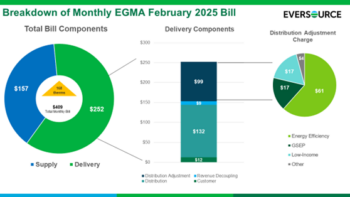
Unlike other energy costs, efficiency is the only investment that is required to pass cost-effectiveness testing. In fact, overall system costs would be billions of dollars greater without the cost reductions secured with efficiency; the more the benefits of improved energy efficiency are reduced, the costlier our energy system becomes.
Figure 7: Benefits of Current Three-Year Energy Efficiency Plans by State (source: Acadia Center)
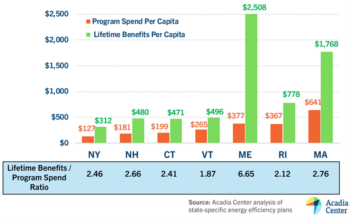
We should be investing even more to give homeowners, renters, and small businesses more tools to control their energy use and utility bills by increasing access to energy efficiency and implementing time-of-use (TOU) rates, plus expanding offerings for demand response and battery storage – which serve as far more cost-effective solutions for peak demand periods than the enormously costly reliability-must-run (RMR) contracts with fossil fuel power plants that ratepayers have had to bear in recent years. Increased oversight and accountability of utility distribution costs can also help drive savings for ratepayers, including via performance-based regulatory approaches to reduce inefficiencies and align incentives.
Looking back over time, the enormous benefits of the region’s energy efficiency benefits are self-evident. They have provided, as recently as 2023, 15% of gross electricity load for the entire region over the course of the year. In this way, energy efficiency helps meet the energy needs of our grid much in the same way as traditional supply resources like gas, oil, and coal. At the end of the day, the lowest-cost source of electricity is the one we never use.
Figure 8: Historic Benefits of NE Energy Efficiency Programs, 2012-2023 (source: Acadia Center)
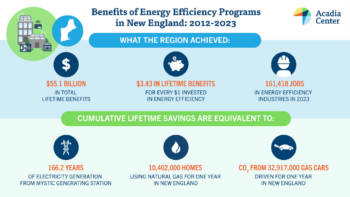
[1] https://www.nbcboston.com/weather/stories-weather/boston-total-snowfall-this-winter/3636399/
New report finds that improved community engagement for clean infrastructure projects is critical to New England’s energy transition
Download the Press Release: EATS Report Press Release
Full Report: The Energy is About to Shift
Webinar:
Webinar PowerPoint: Energy is About to Shift Webinar
Media Contacts:
Samantha Beairsto
Deputy Director, Communications and Development,
Acadia Center
sbeairsto@acadiacenter.org, 617-742-0054 x109
Natalie Volk
Communications Manager
Clean Air Task Force
nvolk@catf.us, 703-785-9580
BOSTON – A new report released today by Acadia Center and Clean Air Task Force (CATF) reveals that enhanced community engagement for clean energy infrastructure projects is critical to achieving New England’s 2050 decarbonization goals. The report highlights the opportunity to accelerate the region’s clean energy progress by addressing local concerns and better equipping communities to meaningfully participate in siting and approval processes. Drawing from prominent case studies around the region, the report also identifies promising options for developers, communities, and policymakers to improve project planning and engagement, helping reduce the risk of failures, legal challenges, and delays. Without comprehensive reforms to improve community engagement processes and modernize siting and permitting policies, the region’s clean energy transition risks significant delays and setbacks.
“Our research shows that when community concerns are not taken seriously, community opposition and distrust can grow, leading to extended project timelines, higher costs, and resistance to future clean energy projects,” said Nicole Pavia, Director of Clean Energy Infrastructure Deployment at CATF. “Whether it’s rural, urban, or suburban communities, community engagement isn’t just a box to check — it’s an essential part of New England’s clean energy future. When communities are meaningfully engaged, we see stronger projects that deliver clean energy benefits while fostering trust, local economic growth, and long-term support for future projects.”
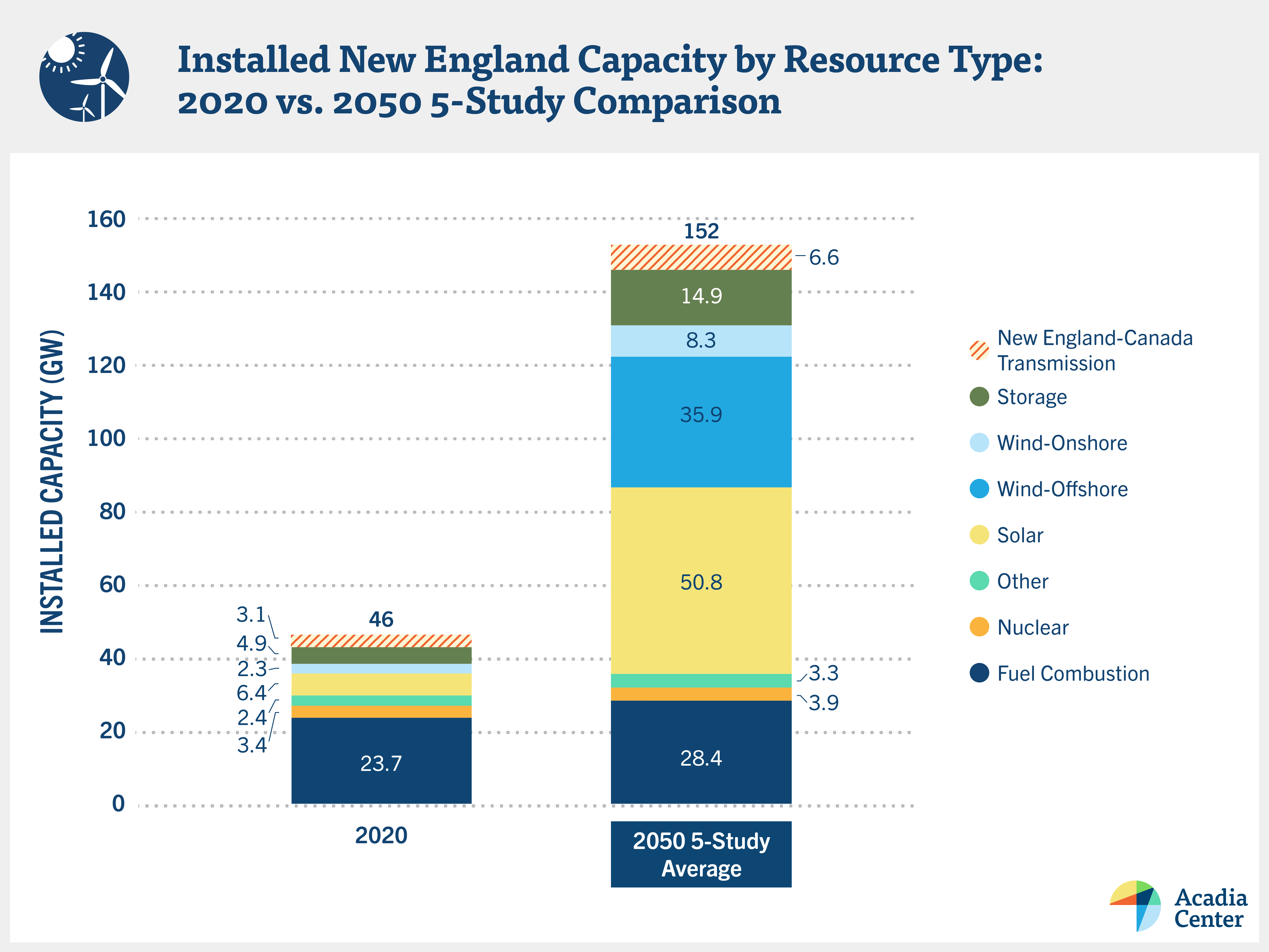
The report includes a comprehensive review of five key studies outlining cost-effective, electrification-focused pathways to decarbonizing New England’s grid and energy systems. The scenarios analyzed reveal that in the 2030s, peak demand for electricity in the region will shift from summer to winter. By 2050, peak demand for electricity is expected to double from 27 gigawatts (GW) to 55 GW, driven largely by the electrification of vehicles and proliferation of heat pumps. To meet the demands of the energy transition, generation capacity in the region will need to more than triple from 43 GW to 145 GW of installed capacity on average, led by increases in solar and offshore wind and aided by transmission system enhancements. Additionally, the report analyzes the diverse portfolio of energy technologies and approaches needed for the future grid – from transmission and generation to energy storage and demand-side resources such as energy efficiency and load flexibility – to maintain reliability, affordability, and resiliency.
“The energy transition will touch all 1,300+ communities in New England, and the region needs a new paradigm for infrastructure siting and engagement that gives those communities a meaningful voice even as the build-out of renewable energy and grid infrastructure accelerates,” said Jamie Dickerson, Senior Director, Climate and Clean Energy Programs at Acadia Center. “The region’s communities and people are at the center of its energy transition just as much as the grid itself is, underscoring the imperative of delivering real community benefits and shifting the environment of engagement toward a virtuous cycle of improved social standing and acceptance.”
The report also examines the challenges and friction points that often hinder positive clean energy development and shape communities’ posture as potential hosts for clean energy projects. Through interviews with stakeholders representing a range of interests – renewable energy developers, state regulators, local community leaders, and more – the report offers a behind-the-scenes look at the real-world factors influencing community support and responses. Case studies highlight key siting and engagement examples in the region, including:
- Vineyard Wind in Massachusetts
- King Pine Wind and Aroostook Renewable Gateway in Maine
- East Eagle Substation and Cranberry Point Energy Storage in Massachusetts
- Johnston Winsor Solar III in Rhode Island
- Twin States Clean Energy Link transmission line between New Hampshire and Vermont
The report outlines actionable options and opportunities state and local governments, project developers, and community stakeholders may take to improve public support for and expedite the deployment of clean energy infrastructure with impactful community benefits. These options are coming into clearer focus as some states in the region have very recently considered and enacted reforms to state siting and permitting laws in 2024, including most notably in Connecticut and in Massachusetts, where lawmakers passed a wide-ranging climate bill anchored around a significant overhaul of the state’s siting and permitting framework.
As these states and the New England region transitions away from fossil fuels to a decarbonized grid, success will depend on active and meaningful community engagement. Without local buy-in, critical clean energy projects will continue to face significant headwinds and delays, putting the region’s climate goals at risk.
On December 5, Acadia Center and CATF will host a webinar to discuss key findings from the report. Read the full report here and register here.
About Acadia Center
Acadia Center is a non-profit organization with over 25 years of experience dedicated to advancing transformative clean energy solutions that promote a livable climate and a more equitable economy in the Northeast United States and beyond. Through rigorous data analysis and strategic partnerships, Acadia Center advocates for policies that significantly reduce carbon emissions and address systemic energy challenges. By collaborating with governments, industries, and communities, Acadia Center’s bold strategies help to ensure an inclusive and sustainable energy future for all.
About Clean Air Task Force
Clean Air Task Force (CATF) is a global nonprofit organization working to safeguard against the worst impacts of climate change by catalyzing the rapid development and deployment of low-carbon energy and other climate protection technologies. With 25 years of internationally recognized expertise on climate policy and a fierce commitment to exploring all potential solutions, CATF is a pragmatic, nonideological advocacy group with the bold ideas needed to address climate change. CATF has offices in Boston, Washington D.C., and Brussels, with staff working remotely around the world.
Acadia Center Offers Rebuttal to Key Points in Flawed Analysis on New England Energy Policies and Costs
Download Press Release: Acadia Center Offers Rebuttal to Key Points in Flawed Analysis on New England Energy Policies and Costs
MEDIA CONTACT:
Kyle Murray
Director, State Program Implementation
kmurray@acadiacenter.org, 617-742-0054 ext.106
Today, a new report entitled “The Staggering Costs of New England’s Green Energy Policies” – released by The Massachusetts Fiscal Alliance, Maine Policy Institute, Josiah Bartlett Center for Public Policy, Rhode Island Center for Freedom and Prosperity, Ethan Allen Institute, Yankee Institute, and Americans for Prosperity Foundation – presents a deeply flawed analysis and distorted view of the region’s future energy outlook. The report, which was conducted by Always on Energy Research (AOER) “concludes that if every New England state maintains their green energy mandates, it will double electric rates and cause rolling blackouts in the region.” Always on Energy Research describes itself as “a policy group dedicated to ensuring that every state in America has affordable, reliable energy.” Their staff have current or past affiliations with groups such as the John Locke Foundation, the American Petroleum Institute (API), the State Policy Network (SPN), and the Center for the American Experiment.
Their analysis and conclusions fail to stand up to even the most basic scrutiny, which is also the case for the related “analysis” and messaging put forward by the Massachusetts Fiscal Alliance in a Commonwealth Beacon OpEd earlier this month – which, based on Acadia Center analysis, overestimated the annual cost of a recently enacted energy storage policy in Massachusetts by more than 25x to 30x, as detailed further below. It is incredibly unfortunate that this report continues to rely upon similar ill-informed assumptions and questionable calculations to vastly inflate the cost of the energy transition by multiple factors.
Breaking Down Misleading Calculations on Energy Storage
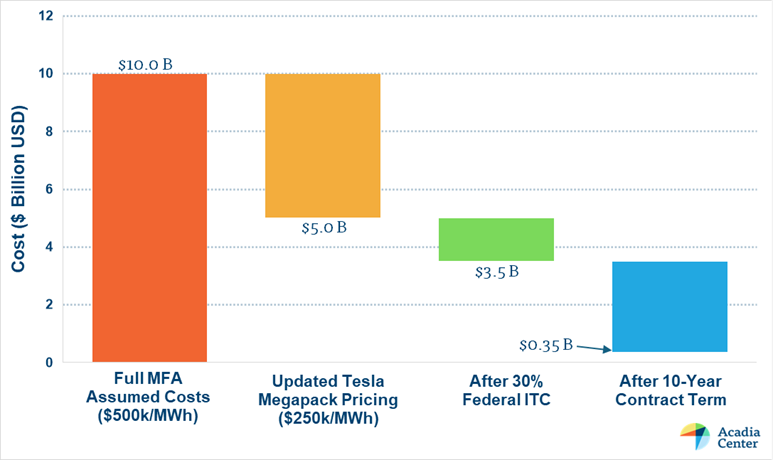
The press release for the AOER report states that “the cost of reducing carbon dioxide emissions under these plans exceeds the benefits of doing so, meaning the New England states are imposing a net harm on their economies after accounting for the financial impacts of climate change.” This characterization could not be further from the truth, and in fact fails to recognize the once-in-a-generation opportunity that New England has: to redesign and revolutionize its energy system and localize the job-creation and GDP impact of energy expenditures within the regional economy rather than export them afar.
Furthermore, the AOER analysis ignores the impossibly high cost of business-as-usual. New Englanders withdraw billions of dollars out of the regional economy each year to purchase fossil fuels sourced outside New England. Vermont, New Hampshire, and Maine alone spend $8.2 billion annually importing fossil fuels. The cost of ignoring the climate crisis is fast becoming incalculable: in 2023 alone, the United States experienced a record-setting 28 separate weather and climate disasters costing at least $1 billion, totaling a cumulative $92.9 billion. The cost of those disasters was also tallied in human lives. This underscores the clear and imminent risk that this region and the nation at large face by not taking the climate crisis seriously. Anything less than urgent action on energy and climate issues is fiscally imprudent and threatens to leave New England families and businesses exposed to both the much larger, hidden costs of unabated climate change as well as the billions of dollars of fossil fuel infrastructure operating today and facing stranded-asset risk.
Let’s be candid: there will be significant costs from the energy transition (and significant benefits as well) – Acadia Center has been clear-eyed about this reality and what it means for our public policymaking. However, using intentionally misleading information to fearmonger on behalf of the fossil fuel industry and advance its interests does not serve the best interests of New England ratepayers. Furthermore, the fact that the region’s GDP has grown while it simultaneously bends the curve on carbon emissions belies the canard that New England state climate policies spell doom for the regional economy. We can address the climate crisis while growing the regional economy and preserving the region’s prosperity. That much has been proved. We look forward to engaging with policymakers and stakeholders constructively on these important public policy debates with a shared set of facts and sound analysis.
Acadia Center presents the following point-by-point rebuttal of several erroneous and misleading claims put forward by the report:
Claim #1 Made by AOER Report: Compliance with the New England Decarbonization Plans would cost $815 billion through 2050
Acadia Center Response #1: The AOER analysis suggests an annual average of $31.3b per year over 26 years (2024-2050). In 2022, the six New England states spent $76b on total energy under the status quo/‘business as usual’ approach. Even if the AOER figures were sound – and they are not – it would be vastly preferable to invest $31.3b per year on clean energy in our region rather than spend the majority of $76b per year on fossil fuels from outside the region, as our current energy system does. In analysis undertaken by Massachusetts, findings showed that the total cost increase of a representative mitigation pathway in 2050 ($1.5 billion annual spending) compared to a non-decarbonized reference case in 2050 was actually less than the expected increase in statewide energy costs resulting from population and economic growth ($2.4 billion annual spending). Finally, the AOER analysis also expressly excludes the impact of federal tax credits, omitting a huge source of likely ‘cost-share’ from the federal government that will make the transition even more affordable for ratepayers.
Claim #2 Made by AOER Report: Residents and businesses can expect electricity rates to double…New England families would see their electric bills increase by an average of $99 per year.
Acadia Center Response #2: Previous extensive modeling conducted by Massachusetts for the Commonwealth’s ‘2050 Decarbonization Roadmap’ and Clean Energy and Climate Plans (CECP) provide evidence for a much different trend for regional energy prices in the coming decades. These studies included granular region-wide energy system modeling to arrive at their results for Massachusetts customers.
- The Roadmap found: “Rates increase out to 2030, then decrease in the subsequent 20 years…. After 2030, growth in electricity load, and vehicle electrification in particular, allows for a reduction in the per‐unit cost of wires on the system,” including thanks to flexible EV charging adding load at night and increasing the load factor in all parts of the system.
- The 2025/2030 CECP found: “The increased adoption of electrified transportation and heating systems means that the average Massachusetts household will spend less money on energy every year. Average overall household energy expenditures, which include transportation-related fuel costs (included as “energy” cost in this analysis), are projected to decline 8% by 2030 relative to 2019 levels, for an average household savings of $400 per year.”
- The 2050 CECP found: “the efficiency gains of electrification will result in lower household energy expenditures through 2050 (monthly bills for electricity and fuels). Transportation and household-related electricity and fuel expenditures are projected to decline by roughly 13% between 2030 and 2050, representing an average of nearly $600 (in 2021 dollars) in 2050 compared to 2030.
Claim #3 Made by AOER Report: The cost of reducing carbon dioxide emissions under these plans exceeds the benefits of doing so.
Acadia Center Response #3: Pathways that invest in local energy resources, including renewable electricity generation and energy efficiency, create more jobs and demonstrate greater economic benefits by keeping money local compared to pathways more reliant on imported energy. For example, the “All Options” pathway from the Massachusetts 2050 Decarbonization Roadmap Study Economic and Health Impacts Report (which emphasized deep electrification and broad renewable electricity buildout) had 17% higher economic “output” (the broadest measure of economic activity) in Massachusetts per dollar invested than the “Pipeline Gas” pathway (which relied heavily on imported alternative fuels). Evidence of these benefits in action is highlighted throughout state clean energy industry reports conducted regularly, such as in Massachusetts, where in 2022, the industry contributed over $14b to Gross State Product, and in Maine, where the clean energy economy now accounts for over 2% of the state’s total workforce, more than 15,000 jobs.
Claim #4 Made by AOER Report: ISO-New England may be unable to coordinate electricity to power the region within 11 years. [Green energy mandates will] cause rolling blackouts in the region.
Acadia Center Response #4: ISO-NE’s own extensive analysis on reliability and resource adequacy have found no such imminent threats to the region’s grid. To the contrary, earlier this year, the largest fossil fuel generating facility in the region (Mystic Generation Station in Everett, MA) was allowed to safely retire without reliability issues, enabled by low-lost local transmission upgrades. Furthermore, findings from ISO-NE’s Probabilistic Energy Adequacy Tool (PEAT) and Regional Energy Shortfall Threshold (REST) workstreams indicate that, in the near-term, the winter energy shortfall risk “appears manageable” over a critical 21-day winter cold-snap period that was the main subject of the analysis. Examination of worst-case scenarios in 2032 indicated an increasing shortfall risk profile in the back half of this decade (2027-2032); however, ISO-NE’s core findings hold true: “Timely additions of behind-the-meter and utility-scale solar, offshore wind, and incremental imports from New England Clean Energy Connect (NECEC) are critical to mitigate energy shortfall risks that result from significant winter load growth and retirements.” In other words, new clean energy is proving vital for reliability and keeping the grid’s peaks manageable. New procurements of energy storage resources (also the subject of questionable analysis, highlighted further below) will also materially improve the resource adequacy and reliability conditions as those resources come online in the years ahead.
Stepping back, “change” has been the sole constant for electric grids since their inception. For example, the US electric power sector delivered 329 terawatt hours (TWh) of electricity in 1950 and 4,090 terawatt hours of electricity in 2022: a 12.4x increase. But dramatic growth alone does not account for all the notable changes to the grid. Due to increasing rates of energy efficiency, the nation is producing more goods and providing more services with improved efficiency, constituting a notable decoupling of GDP growth and electricity consumption. In other words, as dramatic as the growth of the electric grid has been over the last 70 years, that growth has been moderated by cost-effective energy efficiency. There are ample more opportunities to realize such savings from energy efficiency in the years ahead.
Claim #5 Made by AOER Report: Powering New England without interruption during a year in which wind and sunshine are plentiful would require 225 gigawatts (GW) of renewables
Acadia Center Response #5: Acadia Center analysis of five recent leading studies of deep decarbonization in New England identified an average of 150 GW of installed capacity by 2050, including only 95 GW of solar and wind – backed by storage, increased interregional transmission, nuclear capacity, and some remaining combustion resources. See graphic below from the forthcoming Acadia Center analysis, being released in the next week (stay tuned for more).
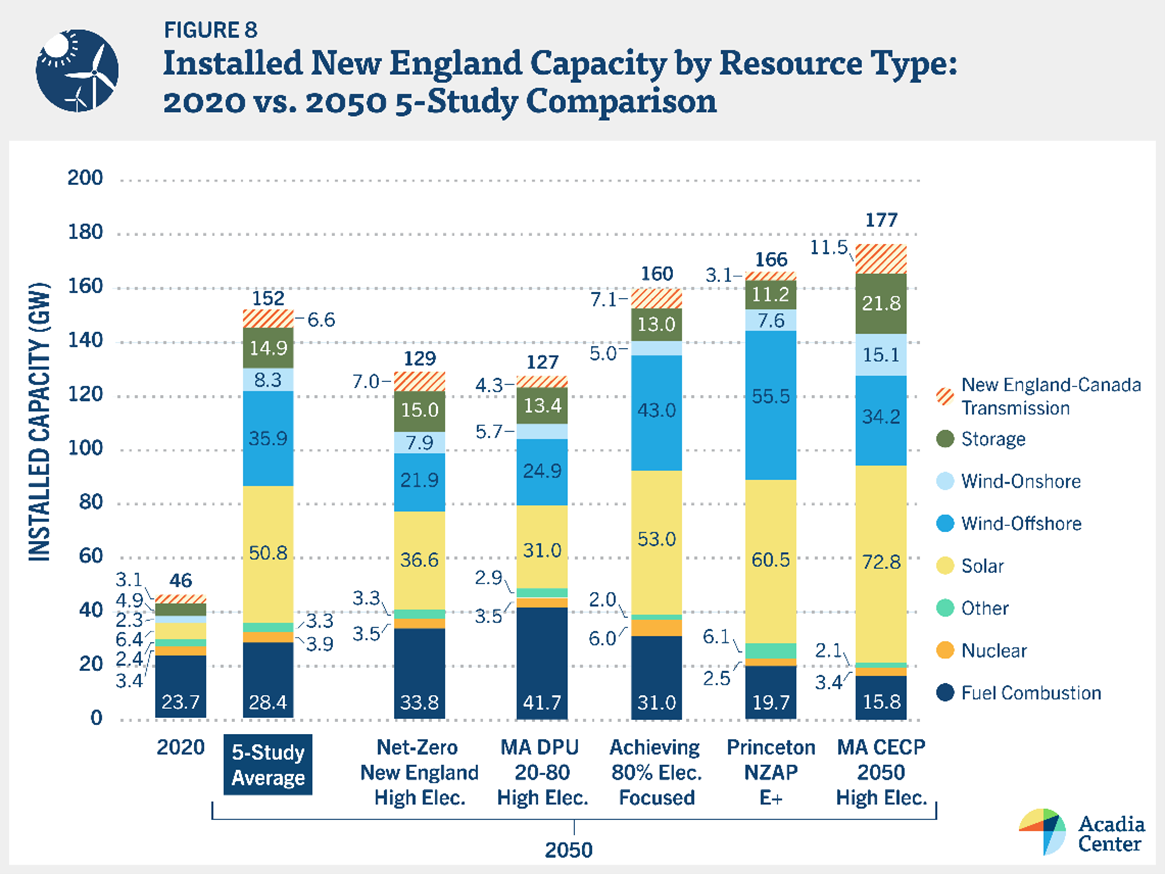
Claim #6 Made by AOER Report: New England is responsible for less than 0.4% of global emissions; it is unclear just how much cleaner the environment will become in exchange for the costs that have been imposed on the region and its people
Acadia Center Response #6: Given the enormous benefits to be reaped from economic output and avoided health care costs, it would be preferable for the region to pursue a low-carbon economy even if climate change were not a global crisis. But the latter is also true, and so it is doubly important for the region to do its part to participate in coordinated global action to reduce carbon emissions. Even the full U.S. as a whole only represents about 13.5% of global emissions – should the largest economy in the world therefore also cease all climate mitigation activities since it can’t solve the global crisis through its own actions? Clearly not. Finally, again, the region has so many engines of clean economic activity coming out of its universities, research laboratories, startup incubators, and beyond, whose full economic opportunity lies in the much more vast work of decarbonization that must occur outside this region. If New England can help prove the case for the cost-effective application of their technologies here, then the world’s energy markets will be theirs to conquer next – and all global citizens will benefit while the New England economy grows.
Claim #7 Made by AOER Report: Battery systems today run around $500,000 per megawatt hour, which yields a total cost of $10 billion, which equals roughly 17 percent of the current state budget (from Commonwealth Beacon piece).
Acadia Center Response #7: The cost of a four-hour “megapack” battery pack from Tesla is publicly available, and it reveals a dramatically lower cost of approximately $250,000/MWh. A 30% federal investment tax credit (ITC) is also available to battery storage projects of this nature. Furthermore, the legislation in Massachusetts requires utilities to enter into cost-effective long-term contracts for storage services, not to purchase storage systems and pay for them outright in one year. Spreading out the systems’ remaining costs over ten years reveals an annualized cost of approximately $350M, or 3.5% of the $10b price tag found by MFA. (See graphic above for more detail illuminating their substantial overestimate of >25-30X.) Even this still overstates the annual cost that would be borne by ratepayers, since contracts would be for only a portion of the full system costs, and since this analysis says nothing about the savings ratepayers would reap by using storage to mitigate the costly and dirty peaks on the grid today. Their discussion also completely ignores numerous cost-control mechanisms directly embedded in the approval process, including the directive to the D.P.U. to ensure contracts are cost-effective, meaning benefits to ratepayers exceed costs incurred.
Acadia Center Applauds Massachusetts Lawmakers and Governor Healey for Passage of Vital Climate Bill, Inclusion of Key Provisions Regarding Siting, Gas Reform, and More
For Immediate Release
November 14, 2024
MEDIA CONTACTS:
Kyle Murray, Director, State Program Implementation
kmurray@acadiacenter.org, 617-742-0054 ext.106
Jamie Dickerson, Senior Director, Climate and Clean Energy Programs
jdickerson@acadiacenter.org, 401-276-0600 x102.
Download Press Release: Acadia Center Press Release 2024 MA Climate Bill
BOSTON — Today, the Massachusetts Legislature enacted a momentous piece of climate legislation that reforms the siting and permitting of clean energy projects, limits natural gas expansion, sets ambitious electric vehicle charging standards, makes needed changes to clean energy procurement, and contains many other reforms that will help drive the Commonwealth forward on decarbonization. Acadia Center applauds the Legislature and the Governor for the leadership demonstrated in shepherding this impactful package of laws to enactment, and urges the Governor to sign this critical legislation as soon as possible. Through the bill package, the Legislature and the Healey-Driscoll Administration are taking tangible steps to drive the Commonwealth’s clean energy future forward in the wake of the federal Election outcome.
Acadia Center is proud to have played an advocacy role in helping build support for a strong package while simultaneously holding the line on the need for a broader bill rather than a narrow package focused only on siting/permitting. The organization stands ready and willing to work with agencies and stakeholders to implement the legislation’s directives, with an emphasis on protecting those who may be most affected by these elements of the broader energy and climate transition. This includes low-income and environmental justice communities, as well as the Commonwealth’s important gas workforce, all of whom deserve a just and equitable transition through the subsequent steps that will now unfold. With these protections identified and prioritized, Acadia Center believes this legislation presents bold yet thoughtful and common-sense changes that will maintain the Commonwealth’s leadership on climate.
Daniel Sosland, President at Acadia Center, said, “The climate crisis has shown itself to be unrelenting in 2024, leaving no room for inaction on policy at the local and state level. Thankfully, legislative leaders in Massachusetts answered the call, ensuring that the Commonwealth will remain a leader on clean energy and retain the momentum of reforms in key areas like infrastructure siting, gas system transition, and beyond. Acadia Center congratulates Chairs Michael Barrett and Jeffrey Roy, along with Governor Maura Healey, for reaching this week’s historic agreement, and we applaud the persistence and creativity shown in working towards a strong final package after the formal end of session. As the focus now shifts to implementation and regulatory action, residents and businesses across the Commonwealth—and even around the region—will begin to see tangible, quality-of-life benefits flowing from improvements to affordability, energy security, grid strengthening, extreme weather resilience, air quality and public health, and job creation and economic development.”
Kyle Murray, Director, State Program Implementation at Acadia Center, said, “Today’s agreement is a major win for the Commonwealth, for ratepayers, public health, climate resiliency, and for our clean energy future. These improvements to modernize siting and permitting processes will help deliver the infrastructure necessary for our electrified and zero-emission future in a way that preserves meaningful community standing and input. Further, the common-sense provisions to limit the growth of the sprawling natural gas system will provide the Department of Public Utilities (DPU) with the needed tools to save ratepayers money on imprudent investments, stranded assets, and leaky pipes. Both branches deserve tremendous credit for a visionary agreement that charts a responsible path forward.
Acadia Center and other advocates were initially deeply troubled when the legislature failed to come to an accord on a climate omnibus before the July 31st deadline for formal sessions. However, we were encouraged by information that the conference committee remained hard at work. Today’s outcome shows that faith has been rewarded with a powerful and balanced bill.
In the legislative agreement reached, the Legislature and Governor came together on a number of directives that will now shape the Commonwealth’s decarbonization pathways, including the following highlights:
- Siting and Permitting:
- Expands/updates Energy Facilities Siting Board (EFSB) authority, including setting a fixed time limit on decision appeals;
- Ensures a smoother path to approval for clean energy projects with a streamlined process;
- Adds a significant definition for cumulative impact analysis; and
- Creates an EFSB and DPU Intervenor Support Fund to provide citizens resources to intervene in these proceedings.
- Gas System Transition:
- Reforms the state’s Gas System Enhancement Plan (GSEP) process to allow for the retirement of pipes instead of simple repair or replacement.
- Ends the unilateral obligation to provide gas service and allows for alternatives to be considered;
- Allows the DPU to consider emissions when reviewing petitions to expand gas company territory;
- Changes the legal definition of a natural gas utility to give them license to deliver geothermal power, a possible first step in changing the business model of natural gas utilities; and
- Requires gas utilities to quantify the costs of potential stranded assets and the benefits of avoiding exposure to such assets.
- Grid-Enhancing Technologies (GETs) and Advanced Transmission Technologies (ATTs)
- Includes suite of provisions to advance the adoption of GETs and ATTs such as dynamic line ratings (DLR) on the Massachusetts power grid
- Incorporates ATTs/GETs into updated definition for transmission/distribution infrastructure under revised siting and permitting/EFSB regime
- Requires utilities to conduct analyses and develop timetables for the adoption of cost-effective GETs/ATT investments, and permits them to propose performance incentive mechanisms (PIMs) to reward progress on these investments.
- Incorporates ATTs/GETs into the prudence requirement utilities must meet for all Electric Sector Modernization Plan (ESMP) investments
- Directs the DPU and DOER to initiate an independent investigation of GETs/ATTs to monitor industry developments and clarify open jurisdictional questions.
- Procurement of Energy Storage, Offshore Wind, and Nuclear:
- Includes language promoting the development of battery storage facilities;
- Tweaks the current regulatory process for procuring offshore wind;
- Allows the state to negotiate power contracts lasting 30 years instead of the current 20 years for offshore wind and battery storage projects;
- Redefines clean energy under Massachusetts law to include power from existing New England nuclear plants – Millstone, based in Waterford, Connecticut, and Seabrook Station, in Seabrook, New Hampshire; and
- Extends renewable energy eligibility to fusion energy if and when it becomes a reality.
- EV Charging:
- Sets EV charger efficiency standards;
- Makes significant changes to the Electric Vehicle Infrastructure Coordinating Council (EVICC), including adding responsibilities for medium- and heavy-duty vehicles providing overall EV leadership/direction;
- Requires the DPU to investigate pole-mounted chargers to implement them more broadly; and
- Removes barriers to EV chargers in condo associations.
- MassPort Charter:
- Changes the MassPort charter to require consideration of greenhouse gas emissions and environmental justice.
While this legislation takes a number of meaningful steps forward, unfortunately the branches were unable to come to a compromise on some key issues that were in either the House or Senate versions of the bill.
- Other important climate/environment elements not included:
- Retail electric supplier ban as a measure for consumer protection
- Expansion of the state’s bottle deposit law
- Commuter rail electrification
- Removing biomass from the Municipal Light Plant Clean Energy Standard
Acadia Center looks ahead with excitement to the opportunity to carry this important work forward and implement the provisions of this historic legislation in keeping with the imperatives of climate, affordability, equity, safety and reliability, and beyond. The organization offers its gratitude to legislative and executive branch officials for their leadership in reaching this important conclusion.
Acadia Center Releases Findings on Regional Greenhouse Gas Initiative (RGGI) Offering Insights into the Allocation of Program Proceeds and Equity Investments
Full Report: Acadia Center RGGI Funds in Action
For Immediate Release
For Release: November 13, 2024
Media Contact:
Paola Moncada Tamayo
Policy Analyst
860-246-7121 x204; 305-504-9720 cell
Program model demonstrates continued impact and the importance of regional, multi-state action and cooperation in wake of federal election outcome.
RGGI Improves Reporting Related to Proceeds Investments Benefiting Environmental Justice Communities but Still Leaves Room for Improved Transparency and More Rapid, Equitable Investment of Program Funds.
Boston, MA – As participating states continue to undertake the Third Program Review of the Regional Greenhouse Gas Initiative (RGGI), Acadia Center today released a report titled RGGI Funds in Action: Insights into the Allocation of RGGI Proceeds, analyzing the investment of RGGI proceeds to date and offering recommendations for improving the process by which future funds are invested. In the wake of the federal election results, the report highlights the continued importance of cooperation at the sub-national level and validates the ongoing benefits that RGGI investments are driving, representing a model for durable multi-state collaboration. The report also examines in detail the first-ever data released jointly by the RGGI states on progress regarding the distribution of investments – totaling 30% – benefitting underserved and environmental justice (EJ) communities, demonstrating some progress but important remaining work to increase equity and improve transparency.
“This report provides more evidence for what Acadia Center has long believed to be true: regional and multi-state action on climate can have real impact. This is more important now than ever. The report’s analysis also shows that the benefits of the RGGI program extend far beyond power plant emissions reductions through the reinvestment of program proceeds into efforts driving clean energy, saving energy, and easing energy burdens,” said Daniel Sosland, President of Acadia Center. “Even as RGGI continues to drive significant benefits, there are still significant improvements to be made to drive greater equity and transparency in the investment of program proceeds. Acadia Center commends the RGGI States for new reporting in this regard and encourages them to go even further to maximize program impact and make a strong case for continued multi-state and regional action.”
“The most recent 2022 RGGI Proceeds Report released by RGGI Inc. in summer of 2024 made a significant advancement in transparency by providing a breakdown of investments directed toward EJ communities for the first time,” said Ben Butterworth, Director, Climate, Energy, and Equity Analysis, at Acadia Center. “Based on the summation of individual state reporting, the RGGI, Inc. report estimates that EJ and equity investments totaled approximately 30% of all RGGI proceeds invested by participating states in 2022. Acadia Center has been calling on RGGI, Inc. to include this data for several years, and we commend RGGI, Inc., and the RGGI states on this initial effort to present this critical data, which can help inform and set the stage for continued equitable investment strategies across the region.”
Notwithstanding this improvement in high-level reporting of RGGI proceeds investments directed at EJ communities, the Acadia Center Report also found that both RGGI, Inc., and the RGGI-participating states can improve the quality of RGGI proceeds investment reporting. In the future, more granular data should include a clear breakdown of who is receiving the proceeds, how funds are being allocated, and what measurable outcomes are being achieved for EJ communities and households across all participating states.
“The aggregated data on EJ investments lack granularity, including a breakout of EJ investment at the individual state level to determine whether each state’s approach aligns with the broader goals of EJ and effective use of proceeds,” pointed out Paola Tamayo, Policy Analyst, and primary analyst of the report. “We encourage RGGI, Inc., to build on its progress by providing more specific information on the categories for EJ funding, which will require the provision of more granular data from state agencies and program administrators responsible for allocating and deploying proceeds investments.”
Acadia Center recommends four key actions that should be taken by RGGI-participating states:
• Establish a requirement that a minimum of 40%-50% of RGGI proceeds are invested in EJ and other underserved communities, setting a value that does not change even if other RGGI funds are raided/diverted.
• Clearly articulate how EJ communities are being defined across all RGGI states and identify in greater detail how these definitions inform which investments are considered as equity and EJ-related.
• Invest in energy efficiency and other clean energy measures as soon as possible to avoid lengthy gaps between auctions and committed/realized investments, address existing energy burdens, and lock-in higher lifetime energy and emissions savings.
• Enhance transparency by publishing detailed breakdowns of proceed allocations going toward EJ and equity priorities for each state, including low-income households. This should be done from both RGGI, Inc.’s reports and state agencies’ reports on RGGI spending.
“Acadia Center’s report highlights how strategic and transparent management of RGGI proceeds is crucial to maximizing the program’s impact on emissions reductions and delivering benefits to underserved communities,” noted Dr. Mark Mitchell, Emeritus Professor of Climate, Energy, and Environmental Health Equity at George Mason University. “Implementing the recommended actions will enhance the effectiveness of the RGGI programs and promote greater accountability, transparency, and community engagement in the allocation of proceeds, building trust in the program and future policies that may emulate elements of the RGGI model.”
Larry Chretien, Executive Director of Green Energy Consumers Alliance, added, “We’ve known from the start that RGGI benefits everyone in the participating states. But there’s always room for improvement, and the Acadia Center report shows us how RGGI can do a better job of cleaning the air in EJ communities. This is an important contribution to the public’s review of RGGI.”
States should look to redouble their efforts in the wake of the election to continue strengthening RGGI while improving the program’s investments to benefit all residents. Acadia Center looks forward to working with the states, RGGI, Inc., and many partners in the coming months to finalize a strong Third Program Review and build on these improvements in the equity and transparency of program investments and reporting.
Additional facts about the benefits of the RGGI program:
1. Significant Emission Reductions: Since its inception, RGGI has successfully helped reduce CO2 emissions from the power sector by nearly 50%, which is 10% more than the 40 states that have not consistently implemented a price on greenhouse gas emissions (Acadia Center’s 2023 report).
2. Economic Benefits: RGGI has generated over $8.3 billion in auction proceeds that states have invested in energy efficiency, renewable energy, and other programs. These investments help create jobs, stimulate economic growth, and reduce energy costs for consumers. (RGGI Inc’s website).
3. Job Creation: RGGI investments have been associated with the creation of thousands of jobs in the clean energy sector. Since its inception, RGGI has created approximately 48,000 job-years (Analysis Group report).
4. Consumer Savings: Programs funded by RGGI proceeds have led to significant energy savings for consumers. In 2022, RGGI investments in energy efficiency are projected to save participants over $1.5 billion on energy bills (RGGI Inc’s most recent proceeds report).
5. Environmental Justice Focus: RGGI states are increasingly directing funds to support environmental justice initiatives. In 2022, 30% of the total RGGI proceeds were reported to be allocated to these initiatives (RGGI Inc’s most recent proceeds report).
###
Acadia Center is a nonprofit research and advocacy organization committed to advancing the clean energy future.
acadiacenter.org


















